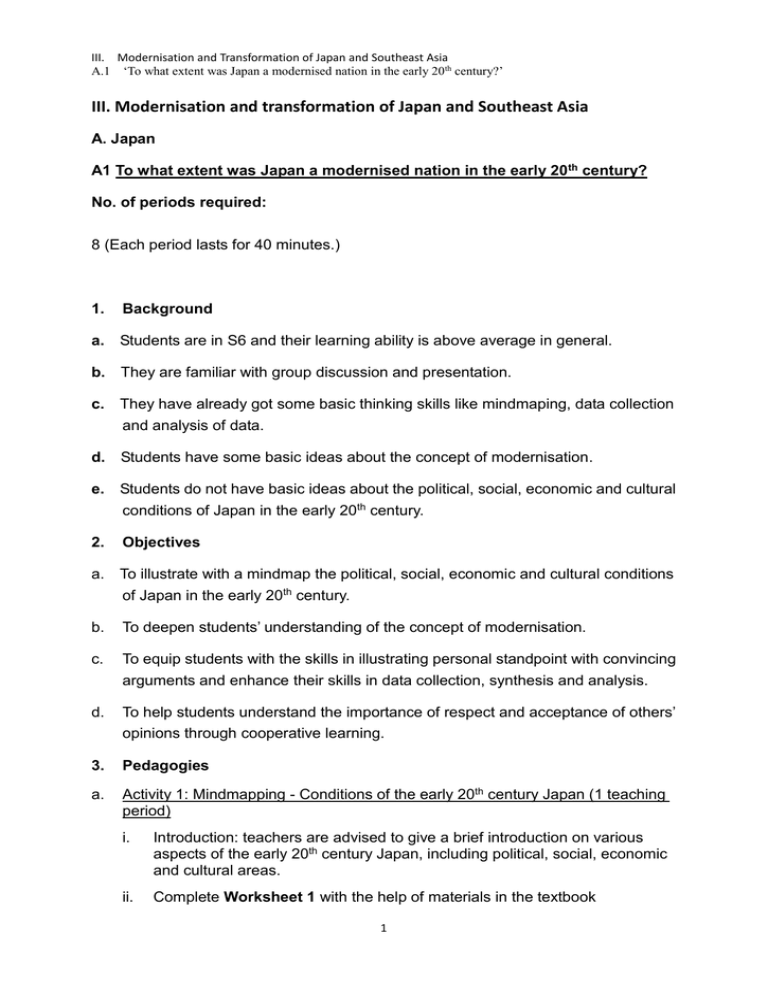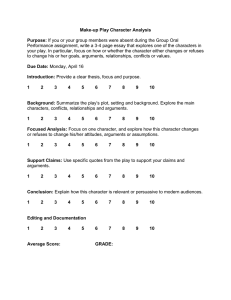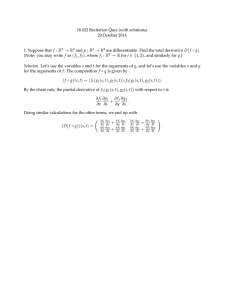Japan A1 e
advertisement

III. Modernisation and Transformation of Japan and Southeast Asia A.1 ‘To what extent was Japan a modernised nation in the early 20 th century?’ III. Modernisation and transformation of Japan and Southeast Asia A. Japan A1 To what extent was Japan a modernised nation in the early 20th century? No. of periods required: 8 (Each period lasts for 40 minutes.) 1. Background a. Students are in S6 and their learning ability is above average in general. b. They are familiar with group discussion and presentation. c. They have already got some basic thinking skills like mindmaping, data collection and analysis of data. d. Students have some basic ideas about the concept of modernisation. e. Students do not have basic ideas about the political, social, economic and cultural conditions of Japan in the early 20th century. 2. Objectives a. To illustrate with a mindmap the political, social, economic and cultural conditions of Japan in the early 20th century. b. To deepen students’ understanding of the concept of modernisation. c. To equip students with the skills in illustrating personal standpoint with convincing arguments and enhance their skills in data collection, synthesis and analysis. d. To help students understand the importance of respect and acceptance of others’ opinions through cooperative learning. 3. Pedagogies a. Activity 1: Mindmapping - Conditions of the early 20th century Japan (1 teaching period) i. Introduction: teachers are advised to give a brief introduction on various aspects of the early 20th century Japan, including political, social, economic and cultural areas. ii. Complete Worksheet 1 with the help of materials in the textbook 1 III. Modernisation and Transformation of Japan and Southeast Asia A.1 ‘To what extent was Japan a modernised nation in the early 20 th century?’ and other relevant reading materials. b. c. iii. Group discussion: Discuss with group members to draw a mindmap representing the group’s ideas on a large poster. iv. Group presentation: students present what they have discussed. v. Conclusion by the teacher. Activity 2: Video Show - Tradition and Modernisation of Japan (1 teaching period) i. Show the video to students. ii. Ask students to finish Worksheet 2. iii. Ask students to discuss the answers of Worksheet 2A. iv. Ask 2 to 3 groups to present their concluding answers. v. Ask students to complete Worksheet 2 B. vi. Conclusion by the teacher. Activity 3: Debate (4 teaching periods) Motion: ‘Japan, to a large extent, was a modernised nation in the early 20th century.’ i. Introduction (2 teaching periods) -All students are asked to finish the Worksheet 3A before grouping. -Explain the rules and flow of debate competition. -Grouping: ii. 2 groups are to be chosen – the Affirmative team and the Negative team Each team consists of 8 students - The 1st, 2nd, 3rd, 4th and Last Speakers & 3 members of the think factory. Other students are to group into 4 teams of judges (no. of judges in each team: 5-6-6-6 ) All students’ performance is to be based on the criteria for assessing the competition - the key is to judge whether the contestants understand the extent that Japan became a modernised nation by the early 20 th century (See Worksheet 3B) The debate (2 teaching periods) 2 III. Modernisation and Transformation of Japan and Southeast Asia A.1 ‘To what extent was Japan a modernised nation in the early 20 th century?’ Students are asked to complete the table in groups to prepare for the debate before the lesson. (See Worksheet 3C) d. Step 1: the 1st and 2nd Speakers of the Affirmative team each speaks for 3 minutes Step 2: the 1st and 2nd Speakers of the Negative team each speaks for 3 minutes Step 3: the 3rd and 4th Speakers of the Affirmative team each speaks for 2 minutes Step 4: the 3rd and 4th Speakers of the Negative team each speaks for 2 minutes Step 5: the Affirmative team and the teacher can raise 2 questions for the Negative Team and the Negative Team can discuss to answer the questions for 1 minute and then answer the questions. Step 6: the Negative team and the teacher can raise 2 questions for the Affirmative Team and the Affirmative Team can discuss the questions for 1 minute and then answer the questions. Step 7: the Last Speaker of the Affirmative team makes a conclusion for 3 minutes Step 8: the Last Speaker of the Negative team makes a conclusion for 3 minutes Step 9: BREAK (5 minutes) - Each team need to choose the best speaker of their team and provide sound evidence to support their choice. 4 groups of judges need to choose the winning team and provide sound evidence to support their choice. (See the Worksheet 3D & 3E) Step 10: Teacher’s conclusion Activty 4: Follow-up Essay Writing Task i. Students are asked to write an essay ‘To what extent did Japan become a modernised nation by the early 20th century?’ ii. Teachers are advised to guide students to study the assessment criteria and to complete the essay based on the criteria, so that they have a clear understanding of the level marking of essay writing. (See Worksheet 4) 4. Expected outcome/difficulties a. Students will have good understanding about the concept of ‘modernisation’ and also the political, social, economic and cultural conditions of Japan in the early 20th century. b. Students’ skills in illustrating personal standpoint with convincing arguments, data collection, synthesis and analysis will be enhanced. 3 III. Modernisation and Transformation of Japan and Southeast Asia A.1 ‘To what extent was Japan a modernised nation in the early 20 th century?’ c. Students will have deeper understanding of the importance of respect and acceptance of others’ opinions through cooperative learning. d. Students may not be able to evaluate the extent to which Japan became modernised by judging and comparing the moderised and traditional conditions in different aspects. 4 III. Modernisation and Transformation of Japan and Southeast Asia A.1 ‘To what extent was Japan a modernised nation in the early 20 th century?’ Worksheet 1 Mindmapping - Early 20th century Japan Draw a mindmap to show the political, social, economic and cultural conditions of Japan in the early 20th century. Then discuss with your members to draw a mindmap representing the ideas of your group on a large poster. Mindmap – Japan in the early 20th century 5 III. Modernisation and Transformation of Japan and Southeast Asia A.1 ‘To what extent was Japan a modernised nation in the early 20 th century?’ Worksheet 2 A Part A: Video Show – “Tradition and Modernisation of Japan” Watch the video about the early 20th century Japan carefully and then answer the following questions. Source: http://www.youtube.com/watch?v=oypz7927ij4&feature=related What are the traditional and western elements shown in the video? Jot down evidences of these elements in the table below. Traditional elements Kimono Traidtional hairstyle of women Traditional apartments Western elements Western suits and dresses Western hairstyle Motor cars, railways Western buildings and department stores a. If you were a woman at that time, how would you feel about the modernisation of Japan? Explain your answer. Free answer b. If you were a worker at that time, what would you do to get a better livelihood? Explain your answer. Free answer 6 III. Modernisation and Transformation of Japan and Southeast Asia A.1 ‘To what extent was Japan a modernised nation in the early 20 th century?’ c. If you were a government leader at that time, what problems would you face? How would you tackle the problems? Free answer d. Do you agree that Japan was modernised in the early 20th century? Explain your answer with reference to the video and using your own knowledge. Free answer 7 III. Modernisation and Transformation of Japan and Southeast Asia A.1 ‘To what extent was Japan a modernised nation in the early 20 th century?’ Worksheet 2 B Part B: Video Show – “Tradition and Modernisation of Japan” Traditional elements Western elements Political Aspect Social Aspect Economic Aspect Cultural Aspect 8 III. Modernisation and Transformation of Japan and Southeast Asia A.1 ‘To what extent was Japan a modernised nation in the early 20 th century?’ Worksheet 3A: Knowledge deepening Study the textbook, notes and any other supplementary information materials and then fill in the relevant information about different roles in the modernization of Japan in the early 20th century. Answers for reference: Roles played Initiator/leader : to lead different parties in the modernization of the nation Supporter/fund provider: to support the government in the modernization by the government Roles played by merchants reforms in terms of provision of funds, investments, etc. Beneficiary: to get benefits from the modernization such as increasing chances of investments, etc. Roles played by workers Supporter/follower: to support the government in the implementation of reform measures Beneficiary: to get benefits from the modernization such as increasing chances of employment, etc. Roles played by peasants Supporter/follower: to support the government in the implementation of reform measures Beneficiary: to get more profits from agriculture due to the growth of economy, etc. Roles played by teachers Follower: to support the government in the implementation of reform measures Beneficiary: to get work in better working condition due to the increasing investment in education, etc. Roles played by students Follower: to support the government in the implementation of reform measures Beneficiary: to get learning in better learning environment due to the increasing investment in education, etc. Roles played by parents Follower: to support the government in the implementation of reform measures Beneficiary: to live in better living environment due to the increasing input of social welfare, etc. Roles played by sons and Beneficiary: to live in better living environment due to the increasing input of social welfare, etc daughters 9 III. Modernisation and Transformation of Japan and Southeast Asia A.1 ‘To what extent was Japan a modernised nation in the early 20 th century?’ Worksheet 3B Assessment Criteria (for Judges) Topic of Debate: ‘Japan, to a large extent, was a modernised nation in the early 20 th century.’ Upper: Clear standpoint with strong evidence/arguments Showing a firm grasp of the gist of the question — the extent Japan became a modernised nation by the early 20th century Effective use of counter arguments to rebuke Clearly expressed, organised, persuasive and coherent Average: Clear standpoint with evidence/arguments Showing a clear grasp of the gist of the question —the extent Japan became a modernised nation by the early 20th century Not effective enough to make counter arguments to rebut Reasonably expressed, organised, Lower: Shows a standpoint with evidence/arguments Shows unclear understanding of the question Weak in making counter arguments to rebuke Weakly expressed and organised 10 III. Modernisation and Transformation of Japan and Southeast Asia A.1 ‘To what extent was Japan a modernised nation in the early 20 th century?’ Worksheet 3C: Debate scripts The First/Second/Third/ Fourth/ Last Speaker Debate ‘Japan, to a large extent, was a modernized nation in the early 20th century.’ Topic Your team: Standpoint & Arguments Opponents’ Team & arguments Counter arguments (predicted) Counter arguments (unpredicted) Guidelines for reference: Standpoint: clear Arguments: strong to support the standpoint & effective use of counte- arguments to rebut Organization: clearly expressed, organized, persuasive and coherent 11 III. Modernisation and Transformation of Japan and Southeast Asia A.1 ‘To what extent was Japan a modernised nation in the early 20 th century?’ Activity Sheet 3D: Assessment (Judges) Topic of Debate: ‘Japan, to a large extent, was a modernised nation in the early 20th century.’ Jot down the key points provided by the 2 sides and write down some feedback below. Arguments Arguments (Affirmative Side) (Negative Side) Feeback: Feedback: 12 III. Modernisation and Transformation of Japan and Southeast Asia A.1 ‘To what extent was Japan a modernised nation in the early 20 th century?’ Worksheet 3E Assessment Mark Sheet (for Judges) Put a in the appropriate boxes below to show the level reached by 2 teams. Arguments (Affirmative Side) Arguments (Negative Side) Upper: Upper: Clear standpoint with strong evidence/arguments Clear standpoint with strong evidence/arguments Showing a firm grasp of the gist of the question—the extent Japan became a modernised nation by the early 20th century Showing a firm grasp of the gist of the question—the extent Japan became a modernised nation by the early 20th century Effective use of counter arguments to rebut Effective use of counter arguments to rebut Clearly expressed, organised, persuasive and coherent Clearly expressed, organised, persuasive and coherent Average: Average: Clear standpoint with evidence/arguments Clear standpoint with evidence/arguments Showing a clear grasp of the gist of the question—the extent Japan became a modernised nation by the early 20th century Showing a clear grasp of the gist of the question—the extent Japan became a modernised nation by the early 20th century Not effective enough to make counter arguments to rebut Not effective enough to make counter arguments to rebut Reasonably expressed, organised, Reasonably expressed, organised, Lower: Lower: Shows a standpoint with evidence/arguments Shows a standpoint with evidence/arguments Shows unclear understanding of the question Shows unclear understanding of the question Weak to make counter arguments to rebut Weak to make counter arguments to rebut Weakly expressed and organised Weakly expressed and organised 13 III. Modernisation and Transformation of Japan and Southeast Asia A.1 ‘To what extent was Japan a modernised nation in the early 20 th century?’ Worksheet 4 Marking Criteria for the Essay To what extent did Japan become a modernised nation by the early 20th century? Criteria Grade (Max. 15) -Coherent presentation with reasonable analysis of the extent to which Japan became a modernised nation by the early 20th century -Balanced contents, with appropriate and effective use of relevant materials; -Clearly expressed, persuasive, and coherent, showing critical and analytical judgment A 14-15 -Shows good understanding of the question’s theme, clearly examine the extent to which Japan became a modernised nation by the early 20th century. Examples cover a considerable part of the early 20th century. B 12-13 -Shows good understanding of the theme of the question, and make concrete attempts to examine the extent to which Japan became a modernised nation by the early 20th century; but the discussion is obviously lopsided to arguments for modernisation, and/or contains underdeveloped arguments. Examples cover a considerable part of the 20th century. C 10-11 -Shows general understanding of the question, and the discussion attempts to give balanced arguments, but marred by rough arguments and/or vagueness in discussing ‘extent’. D 8-9 -Shows awareness of the question, narrates on both sides of the arguments and attempts to reach a conclusion about ‘extent’, though marred by rough arguments and overgeneralization. - Contains obvious factual errors. E 6-7 - A narration of examples showing how Japan was modernised, without mentioning the other side of the arguments; or - Attempts to discuss ‘extent’, though primarily on examples other than those for modernisation E/F 5 - A narration of examples other than those for modernisation, or - A narration of the development of Japan, without discussing the extent to which Japan became a modernised nation. F 3-4 Adapted from “Sample Paper and marking scheme reference for HKDSE History 2009” with permission of the Hong Kong Examinations and Assessment Authority. 14




